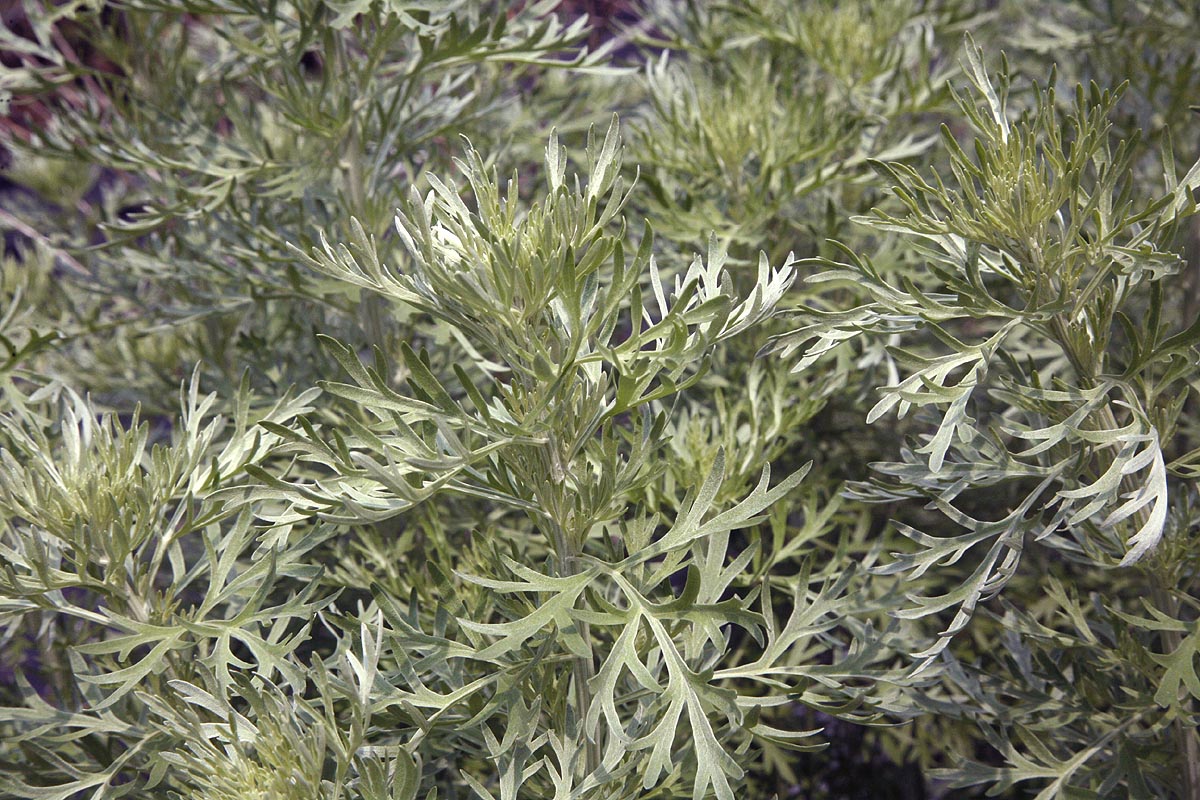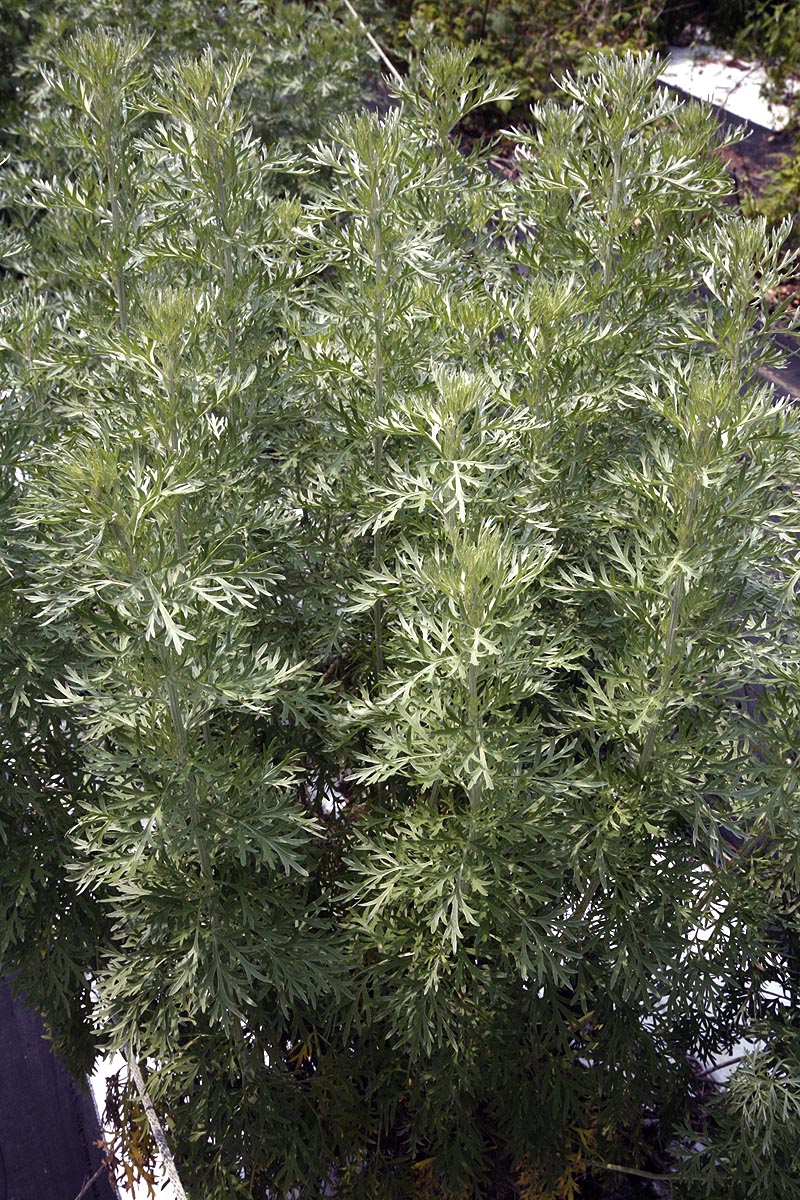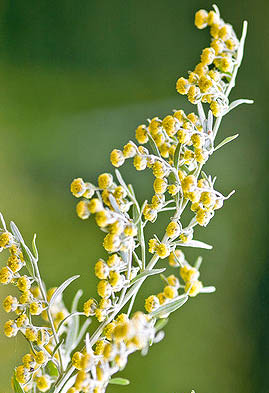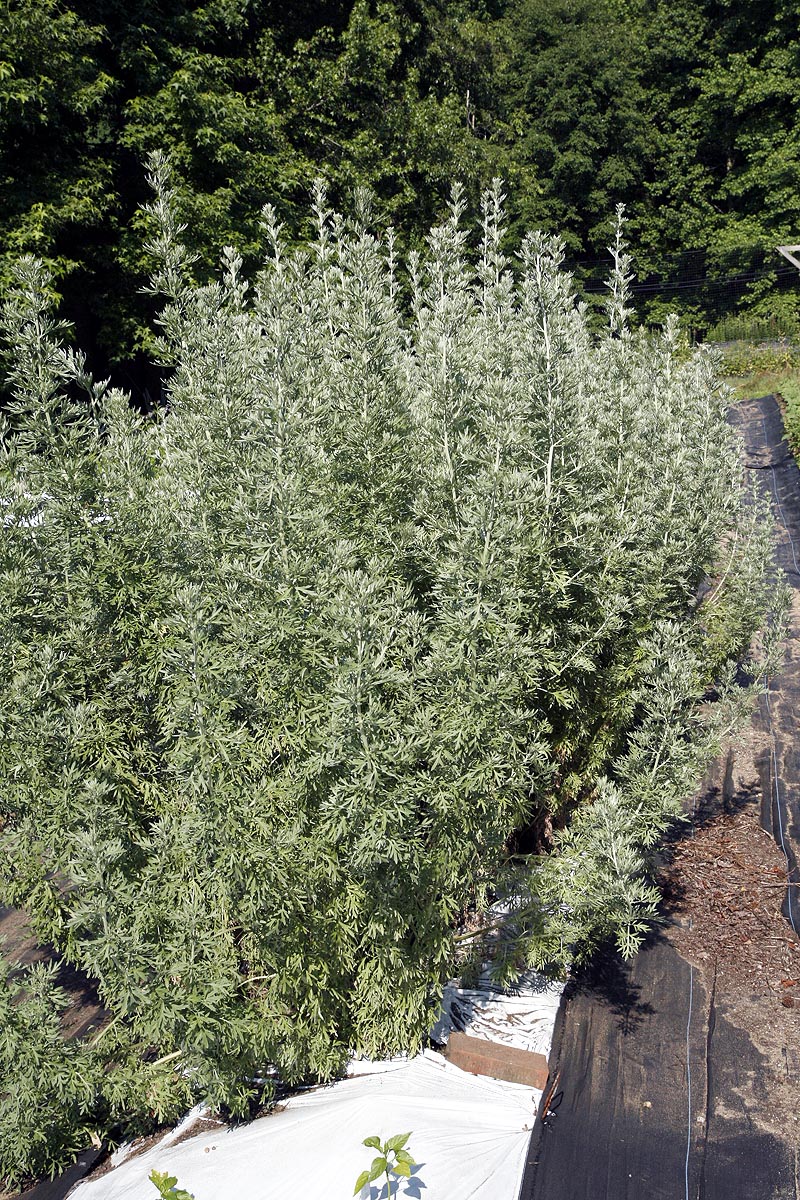Wormwood is a very hardy attractive perennial that will grow almost anywhere even on poor soils often with little water.. Needs full sun to partial shade and little maintenance. Hardy from zones 4a - 8b With silvery gray foliage growing in clumps up to 2-3 feet across it can make a very dramatic statement in the garden. The small yellow flowers that appear on 3 feet tall flowers stalks are almost a bonus to the lovely foliage. Due to its bitter taste and sharp aroma it is disliked by most wildlife making it idea for gardens with deer and rabbits. It's a lovely care free plant for any garden.
Description of Wormwood (Artemisia Absinthium).
Wormwood is a very attractive hardy perennial. In its first year it produces
a small mound of deeply cut lacy composite leaves. Each leaf stem is light green
almost white and has pairs of leaflets deeply cut or lobed in pairs. Leaflets
can be up to 3" long making the whole leaf about 12". Leaves are gray-green
or silver-green on both sides and covered in fine silvery hairs. From its second
year onwards the plants put up tall upright flowering stems that can reach 3
feet in height. These have groove stems with spirally arranged silvery leaves
and topped with cascading panicles of small yellow flowers. These are tiny composite
flowers almost globular in shape and flower from mid summer to mid fall, giving
the plant a longer flowering season. This is followed by tiny wind blow seeds.
Wormwood forms large clumps spreading by underground rhizomes and sending up
new shoots to increase its size. Plants can reach 2-3 feet wide and make an
impressive display of silver green foliage. The leaves and flowers have a bitter
odour which some report as similar to sage with bitter overtones.
Growing Wormwood (Artemisia Absinthium) from Seed.
Seeds are very small so starting indoors is recommended. Start in good potting
soil and sow seeds on the surface of the soil. Seeds need some light to germinate
so either don't cover them or give them a light dusting to help get a good
soil contact. Keep moist until seedlings appear, seedlings are very small and
delicate and take quite a while to grow to any size. When large enough to handle
pot into individual pots and grow on until large enough to transplant to their
final location. This can take several weeks as they grow very slowly to begin
with . For more detailed instructions on starting seed see our general
growing instructions. Seedlings grow fairly slowly to begin with as they
establishing themselves in the first year. Plant at least two feet apart as
plants can become quite large once established.
Direct sowing.
Seed can be sown from spring through early fall if desired. However since seed
is small and takes a while to grow to a reasonable sized plant they can easily
become overwhelmed by weeds. If you have a lot of seed and only want a few plants
then outdoor seeding is fine, but if seed is limited we recommend indoor seeding
to maximize the number of plants you produce.
Location and Care of Wormwood (Artemisia Absinthium).
Wormwood is a tough plant, it can tolerate many different climatic types and
poor soil. It is a native to Europe and Asia growing all the way from Siberia
to northern Africa. It will grow quite happily from U.S. zones 4a - 8b. Its
preferred location will therefore depend on its latitude. In cooler areas it
prefers full sun and is commonly seen on grasslands and pastures. In warmer
areas it prefers some shade especially from the noonday sun.
Wormwood will grow on a wide range of soil types and is often found on poor
soil that is semi dry in its native grasslands. In warmer areas it prefers a
slightly richer soil and more water. You may need to experiment with your plants
location to determine what it likes best in your area. In most cases, plants
in shade and those that have more water tend to be less silvery and more green.
Plants under more stress produce a much stronger silvery appearance. It will
not grow well in moist to wet soils.
Fortunately wormwood does not mind being transplanted so moving it around until you find its best location should not be a problem Wormwood is however a fairly short lived perennial, usually living about 3-5 years. It does however reseed easily so keeping your wormwood patch going is realtively easy.
Once established wormwood needs little care, it's a tough plant and usually
does not need much watering, but in hotter areas may need some additional watering
if insufficient rainfall. Plants die down in the winter, surface material can
then either be cut to the ground or left until spring to provide winter interest
in the garden.
Since the seeds are windblown it can seed itself in unwanted areas so cutting
down seed heads before they have chance to spread the seeds may be desirable,
especially if you are close to open range or pasturelands.
Prune back flowers if plant is being grow for leaf harvest as flowers inhibit good leaf production.
Wormwood contains large amounts of a compound called absinthin which is a water
soluble growth inhibiting toxin. It is secreted from the roots and can wash
off the plants into the area around it. This will cause any plants around it
to become stunted and they may even die. So don't plant wormwood too close to
any other plants especially ones that you treasure.
However if it is planted as a 'hedge' around vegetable gardens or delicate plants
it can act as a barrier helping to prevent soil organisms from travelling into
the vegetables. It may also confuse other pests such as carrot
The strong acrid scent of the plant makes it very unattractive to animals so it's a great deer resistant plant.
Diseases of Wormwood (Artemisia Absinthium).
While wormwood is fairly resistant to most diseases it can on occasion have
fungal problems. This is usually in the form or White rust ,Downy mildew, Powdery
mildew and Fungal leaf and stem rots especially in overly moist sites. This
is more common with plants grown in warmers climates, those in shaded areas
and moister locations. Those grown in sun on dryer soils seldom get problems.
Harvesting of Wormwood (Artemisia Absinthium).
All healthy leaves and flowers stalks can be harvested for later use. Choose
a dry sunny day and harvest after all dew has dried from the plants. Take only
the good healthy leaves, discard any that are discolored or old. The best time
to harvest is just as the flowers are blooming this is when the phytochemicals
(in this case mostly absinthin) are at their highest. Collect into small bunches
and fasten with a rubber band, hang to dry in a warm dark area with a reasonable
air current. When dry fold into air tight containers and store for later use.
Medical uses of Wormwood (Artemisia Absinthium).
Wormwood has a very long history of use as a medicinal herb, it can be traced
back to early Egyptian use in 1600 B.C. Wormwood got its name because it is
extremely good at removing intestinal parasites hence 'worm wood'. It is also
extremely effective to help aid digestion, it can help with indigestion and
gastric pain. It has been used for centuries as a tonic for the liver gall bladder
and digestive system. It is an extremely useful medicine for those with weak
and under-active digestion as it helps to increase stomach acid and bile production,
improving digestion and the absorption of nutrients. The leaves have also been
used effectively to treat anorexia nervosa. It is also a powerful blood stimulator
helping to improve overall circulation. Recent studies are considering its use
for beast cancer support. There are also reports of it being used to give relief
in morning sickness, prevents threatened miscarriage, soothe earaches and ear
infections, and treat obesity.
Homeopathically, wormwood is employed to treat such ailments as epilepsy, nervous
ticks and muscle spasms. Externally when made into a warm tea or poultice it
is applied to bruises and bites and on sprains and strained muscles to relieve
pain and swelling.
It is also reported that wormwood will counteracted the effects of poison hemlock.
Culinary uses of Wormwood (Artemisia Absinthium).
Wormwood is used to flavor the one spirit absinthe a popular alcoholic drink.
It is also used in some forms of vermouth and wines. In 18th century England
when access to hops was scarce wormwood was used as a substitute. It was also
used the Middle Ages it was used to spice mead.
Is it poisonous?
To start with, anything taken in large enough doses is poisonous. Wormwood is
never usually ingested in such large quantities as to cause any harm. It has
also been reported widely that some of the compounds especially thujone causes
hallucinations and other mental instability. Recent research has shown that
this is totally untrue. It does none of these things. The whole story was based
upon historic use of absinthe. At this particular time alcohol was in shorter
supply and poor quality substitutes were used. (similar to some of the poisonous
stuff that was produced during prohibition in the United States). It was these
compounds in the alcohol used to make cheap wormwood that were the cause of
hallucinations, addiction and mental instability. Even today if you choose to
flavor paint thinner with wormwood and drink it, you would get the same results,
but it would not be the wormwood at fault.
Other uses of Wormwood (Artemisia Absinthium).
Insect repellent.
The compounds in wormwood are very repellent to many kinds of insects including,
ants, fruit flies aphids, cabbage moths, beetles, mites, fleas, and others.
The dried leaves can be scattered around ants nests, the base of fruit trees
or vegetable gardens to deter insects and also slugs and snails. Or a tea can
be made from the leaves and sprayed onto the plants as an insecticide. Adding
the tea to a dogs bath can help deter fleas.
The fresh herb can also be rubbed onto the skin to act as a natural insect repellent or spray yourself with the tea.
Protecting plants from insects.
Wormwood can also be used as a 'hedge' around vegetable gardens to help deter
insects from attacking the plants. Just ensure that the plants are not too close
to the wormwood so they become stunted from the absinthin exuded by the plants.
The roots also produce this compound and this will help deter any soil living
pests from passing them and entering the vegetable plot. It may also deter deer
from entering since they also dislike the plant.
Wormwood also makes a interesting range of natural dies from light to nettle
green.
Wormwood is also a very attractive dried flower and makes a wonderful 'filler'
for displays.
Other names.
Absintalsem, Absinth Sagewort, Absinth Wormwood, Absinthe, Absinth Ajenjo, Ajenjo
Oficial, Common Wormwood, Feuilles Ameres, Niga-Yomogi, Old Woman, Oldman, Pelin,
Wormswood, wermuth, wermud,
Green Ginger
Also. Absint-alsem (Dutch), Absinthe, Ambrosia (Ancient Greek), Assenzio Vero (Italian), Gengibre Verde (Spanish, 'green ginger'), Green Muse, Grune Fee (German, 'greem fairy'), Hierba Santa (Spanish, 'sacred herb'), Rihan (Arabic), Sage of the Glaciers, Wermod (Saxon), Wor-mod (Old English).









